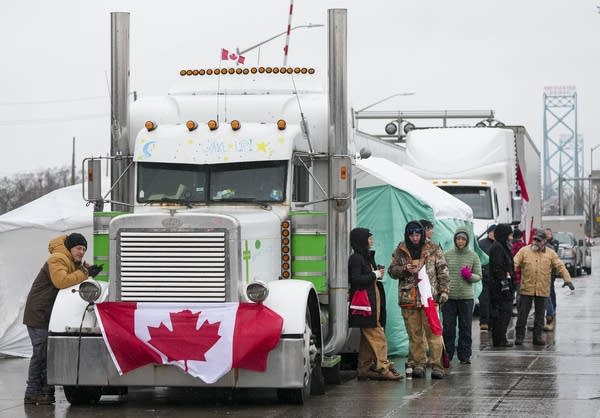Truckers protesting in Canada end last U.S. border blockade

Go Deeper.
Create an account or log in to save stories.
Like this?
Thanks for liking this story! We have added it to a list of your favorite stories.
A Canadian official says truckers protesting the country's COVID-19 restrictions are dismantling their last remaining blockade along the U.S. border. Meanwhile, the siege of Ottawa appears to be heating up.
The federal official says the final blockaders are leaving Emerson, Manitoba, opposite North Dakota, and border authorities hope to reopen the crossing in the afternoon.
The official was not authorized to discuss the matter publicly and spoke on condition of anonymity Wednesday.
At the same time, police in Canada’s capital are telling truckers who have clogged Ottawa's streets that it is time for them to leave too.
Turn Up Your Support
MPR News helps you turn down the noise and build shared understanding. Turn up your support for this public resource and keep trusted journalism accessible to all.
Authorities began handing out notices and threatening arrests Wednesday near the Parliament building where the biggest group of protesters is entrenched.
Authorities in yellow “police liaison” vests went from rig to rig, knocking on the doors of the trucks parked outside Parliament, to serve notice to the truckers that they could also lose their licenses and see their vehicles seized under Canada’s Emergencies Act.
Police also began ticketing vehicles.
Some truckers ripped up the order, and one protester shouted, “I will never go home!” Some threw the warning into a toilet put out on the street. Protesters sat in their trucks and defiantly honked their horns in a chorus that echoed loudly downtown.
At least one trucker pulled away from Parliament Hill.
There was no immediate word from police on when or if they might move in to clear the hundreds trucks by force. But protest leaders braced for action on Wednesday.
“If it means that I need to go to prison, if I need to be fined in order to allow freedom to be restored in this country — millions of people have given far more for their freedom,” said David Paisley, who traveled to Ottawa with a friend who is a truck driver.
Marie Eye, of Victoriaville, Quebec, who has been making soup for the protesters, said the warnings were “just a piece of paper” and doubted police had the manpower to remove the rigs or the protesters.
The warnings came just days after Prime Minister Justin Trudeau invoked the emergency law.
Since late January, protesters in trucks and other vehicles have jammed the streets of the capital and obstructed border crossings, decrying vaccine mandates for cross-border truckers and other COVID-19 precautions and condemning Trudeau’s Liberal government.
The protests have drawn support from right-wing extremists and have been cheered on and received donations from conservatives in the U.S., triggering complaints in some quarters about America being a bad influence on Canada.
As the crisis appeared to heat up in Ottawa, the premiers of two Canadian provinces and 16 U.S. governors sent a letter to Trudeau and U.S. President Joe Biden calling on them to end their nations’ requirements that truckers crossing the border be vaccinated.
Just one blockade remained at the U.S. border, and the Royal Canadian Mounted Police said they expected the last remaining demonstrators to leave the site at Emerson, Manitoba, opposite North Dakota, by early Wednesday afternoon, with the Mounties escorting the vehicles out.
In Ottawa, the bumper-to-bumper demonstrations by the so-called Freedom Convoy have infuriated many residents, who have complained of being harassed and intimidated on the clogged streets.
Police in Ottawa were optimistic they could gain control in the coming days after Trudeau invoked the Emergencies Act on Monday.
Over the past weeks, authorities have hesitated to move against the protesters, citing in some cases a lack of manpower and fears of violence.
Trudeau’s decision came amid growing frustration with government inaction. Ottawa Police Chief Peter Sloly lost his job this week after he failed to move decisively against the demonstrators.
Interim Ottawa Police Chief Steve Bell said Tuesday he believes authorities have reached a turning point: “I believe we now have the resources and partners to put a safe end to this occupation.”
But protesters in the capital appeared to be entrenched. On Tuesday, Ottawa officials said 360 vehicles remained involved in the blockade in the city’s core, down from a high of roughly 4,000.
“They don’t want to give this up because this is their last stand, their last main hub,” said Michael Kempa, a criminology professor at the University of Ottawa.
Even after the warnings, a few protesters roasted a pig on the street in front of Parliament, and a child played with blocks in a small playground area on a road lined with trucks.
An Ottawa child welfare agency advised parents at the demonstration to arrange for someone to take care of their children in the event of a police crackdown. Some protesters had their youngsters with them.
Police in the capital appeared to be following the playbook that authorities used over the weekend to break the blockade at the economically vital Ambassador Bridge connecting Windsor, Ontario, to Detroit. Police there handed out leaflets informing protesters they risked arrest.
After many of those demonstrators left and the protest had dwindled, police moved in and made dozens of arrests. The blockade there had disrupted the flow of goods between the two countries and forced the auto industry on both sides to curtail production.


